I love pizza. There were phases in my life when I had a New York slice for lunch or dinner at least five times a week. I have since transitioned to a more reasonable cadence of one individual pie on weekends, usually of the Neapolitan persuasion. That’s not to say that just because the city has discovered wood-fired ovens and the Naples school, I’m poo-pooing the good old New York slice. I’m not the only one, apparently, as Wylie Dufresne’s newly open Stretch Pizza can attest. Apparently tired of baking donuts in Brooklyn, the former wd~50 chef joined forces with the owner of Breads Bakery for another single-dish eatery. What started as a six-month residency inside one of the bakery’s branches has now turned into a full-fledged restaurant. Next to New York classics (plain, pepperoni), Dufresne serves some of his own creations.
So what does this have to do with Slovenia, you may ask? Don’t you worry: as the inventor of the Russian Far North pizza, I’ll easily sell you that bridge. The idea came to me when I tried Stretch Pizza’s Ploughman, a white pie with thinly shaved ham and sliced red onion on a base of mildly smoked cheddar, topped with finely grated horseradish and chopped chives. This immediately transported me back to some of my first meals in and around Ljubljana. Slovenian food has a strong German influence, but also, as you travel westward, an Italian one. And yes, that means pizza restaurants.
So here I am, combining ideas from Dufresne’s creation with several culinary memories from my recent Slovenian trip – a beef tongue carpaccio, a salad of beef leftovers with red onion and gherkins, the horseradish grated in a sour cream sauce or on a meat stew, the pizza eaten for lunch as a hangover cure. Slovenia even produces an Emmental-style cheese, bohinjski sir (from the Bohinj region, first made in 1873 by a visiting Swiss cheesemaker on a mission to educate local shepherds about his country’s food). I’m not making a Neapolitan-style pizza because what you encounter in ex-Yugoslavia is more of a catchall crust (not that different from New York crust, actually). My dough recipe, suitable for a home oven, is adapted from the excellent Mastering Pizza by Marc Vetri, with the addition of glycerol monostearate (available here) for an airier dough. It’s damn good, ready in less than a day but still rested long enough for flavor development. Use it for all your pizzas, whether Slovenian or not!
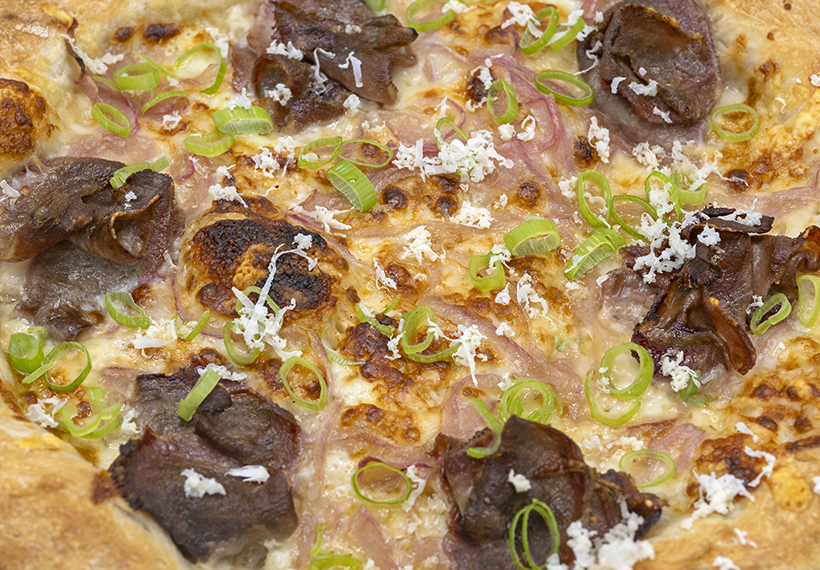
Slovenian pizza
Yields 1 individual 25 cm pizza (except the beef tongue, which makes about 10 servings)
Total preparation: 31 hours
Active preparation: 1 hour
Beef tongue sous-vide
1 beef tongue, about 800 g
about 8 g salt
- Bring a pot of water to a boil. Add the beef tongue, cook for 2 minutes, then remove and let cool.
- Weigh the tongue and measure 1% of that weight in salt. Place the tongue and salt in a sous-vide pouch, vacuum seal, and cook in a 68 C / 154 F water bath for 24 hours.
- Take the pouch out of the water and let cool for a few minutes. Open the pouch and discard the liquid. Peel (and discard) the skin off the tongue, then wrap in plastic or in a sous-vide pouch and refrigerate for at least 6 hours. The tongue can be kept for up to 3 days.
- To prepare the pizza topping, shave the beef tongue using a meat slicer on a very thin setting.
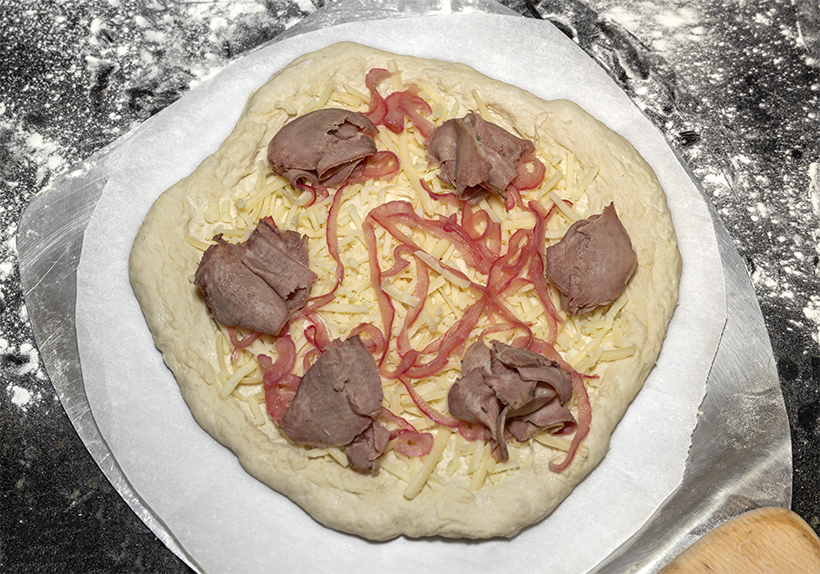
Pizza dough
115 g water at 13 C / 55 F
0.5 g active dry yeast
165 g bread flour, plus some for dusting
1 g glycerol monostearate
15 g extra virgin olive oil
4 g salt
- Pour the water into the bowl of a stand mixer fit with the flat beater attachment. Sprinkle the dry yeast over the water and mix on low speed for a few seconds.
- Add the flour and the glycerol monostearate, and mix on low speed until the dough comes together, about 2 minutes. Add the olive oil and salt, and mix for another 30 seconds.
- Switch to the dough hook attachment, and continue mixing on low speed for 12-15 minutes, occasionally scraping down the walls of the bowl. The dough should form a ball, and barely look greasy.
- Cover the bowl with plastic wrap, and let the dough rest at room temperature until it has doubled in volume, about 2 hours.
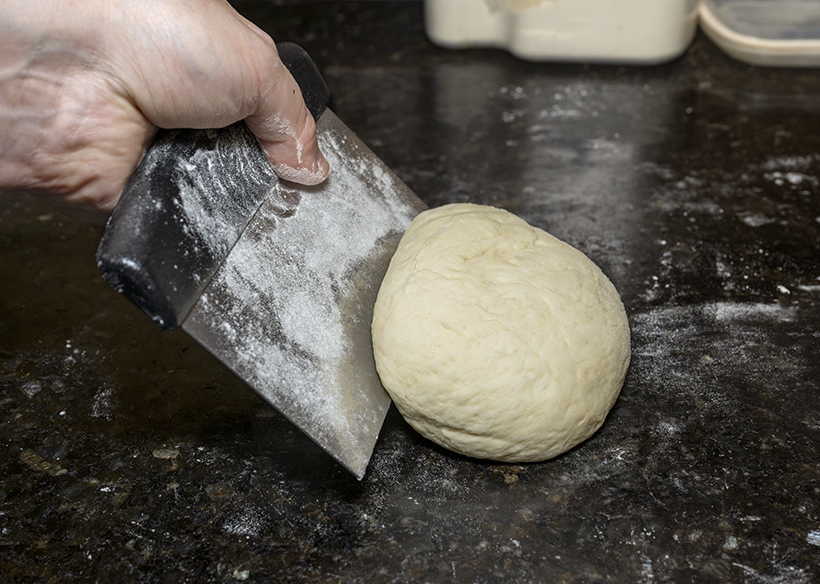
- Lightly flour your hands and a bench scraper, but not your work surface. Use your hand to scrape and dump the dough onto your work area (in case you decided to scale up the recipe, the dough for one pizza should weigh 290-295 g). Roll the dough around by pushing and flipping it with the bench scraper so that it takes an oval shape. Repeat this process in different directions until the dough takes a rounder shape. Transfer to a proofing box or half-sized hotel pan. Cover with a lid or plastic wrap and let rest at room temperature for 6 to 12 hours. The dough will flatten out quite a bit, which is okay. It should be used within that 6- to 12-hour time frame; it should not be kept any longer than that.
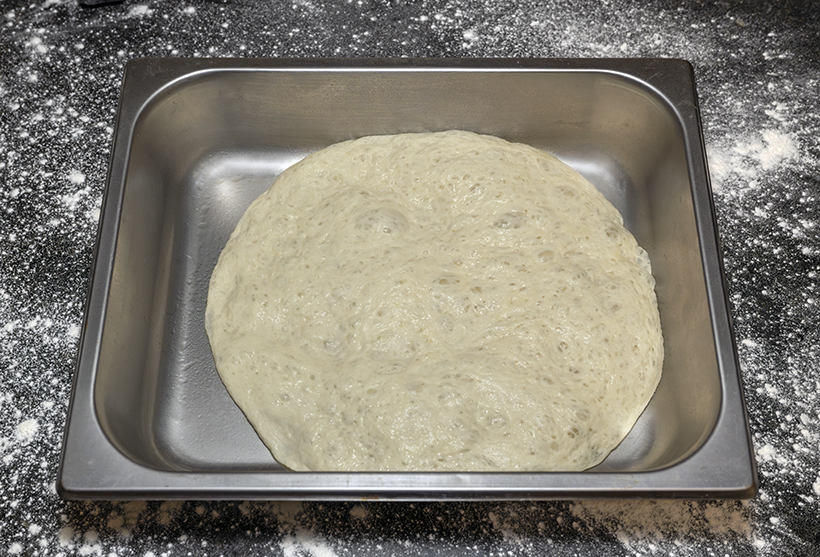
Pickled red onion
35 g red wine vinegar
15 g water
15 g sugar
25 g peeled red onion, thinly sliced
- Combine the vinegar, water, and sugar in a bowl. Heat in the microwave for 30 seconds, and stir until the sugar is fully dissolved. Add the onion, and marinate for 2 hours at room temperature, stirring once or twice.
- Strain and reserve the pickled onion at room temperature.
Assembly
40 g low-moisture mozzarella, shredded
40 g aged Emmental cheese, grated
pickled red onion
50 g shaved beef tongue
1 g smoked salt
bread flour, for dusting
pizza dough
about 4 g scallion greens
about 2 g fresh horseradish
- Place a baking stone on the upper rack of the oven, 10-15 cm beneath the broiler for an electric oven, 15-20 cm for a gas oven. Preheat the oven to its highest setting (usually 260-300 C/500-550 F) for 45 minutes.
- Prepare all the toppings: the mozzarella and Emmental combined in a bowl, the pickled red onion drained on paper towels, and the shaved beef tongue seasoned with the smoked salt.
- Reset the oven to high broil, and preheat the broiler for 5-10 minutes while assembling the pizza.
- Generously flour a work surface and a pizza peel lined with parchment paper. Scrape the dough ball from the pan onto your work area. Gently press your fingers all around the dough, about 1 cm from the edges, to form the rim; the center should look thicker, like a hat (see photo). Transfer to the parchment paper on the pizza peel.
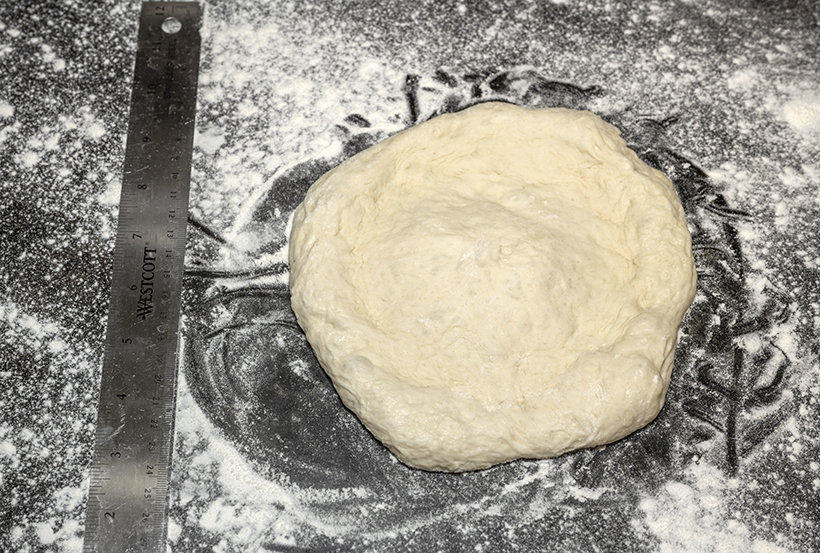
- Press your fingers and palm gently into the center of the dough, moving your fingers and thumb outward to stretch the dough away from the center. Repeat this process, gradually rotating the parchment paper, until you have a 15-20 cm disc. Let the dough relax for a couple minutes, then finish stretching to a 25 cm diameter disc of even thickness across the middle with a thicker rim around the edge. If you tear a hole in the dough, patch it using a little dough pulled from the rim.
- Sprinkle the cheese evenly on the pizza, followed by the pickled red onion. Arrange the beef tongue in six little mounds distributed evenly.
- With the oven still on high broil, slide the parchment paper with the pizza from the peel onto the pizza stone and cook for 5 minutes. Take the pizza out (closing the oven immediately to preserve the heat), turn it 180 degrees, remove the parchment paper, and put the pizza back in. Cook another 1-2 minutes until the rim is puffed, the dough is charred in spots, and the bottom is crisp.
- Remove the pizza from the oven and slide onto a cutting board. Sprinkle with the scallion greens, and shave the horseradish on top using a Microplane grater. Let cool for a minute.
- Cut into 6 slices and serve.
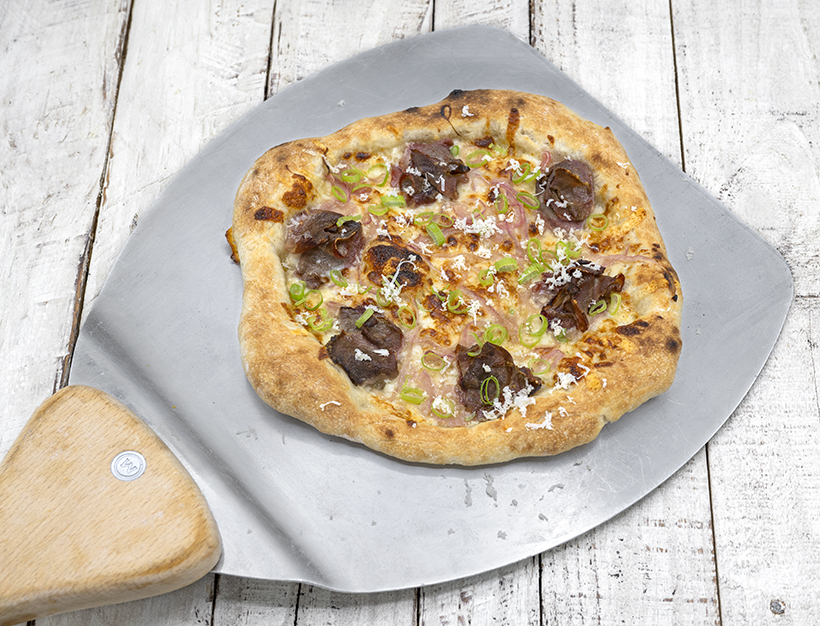

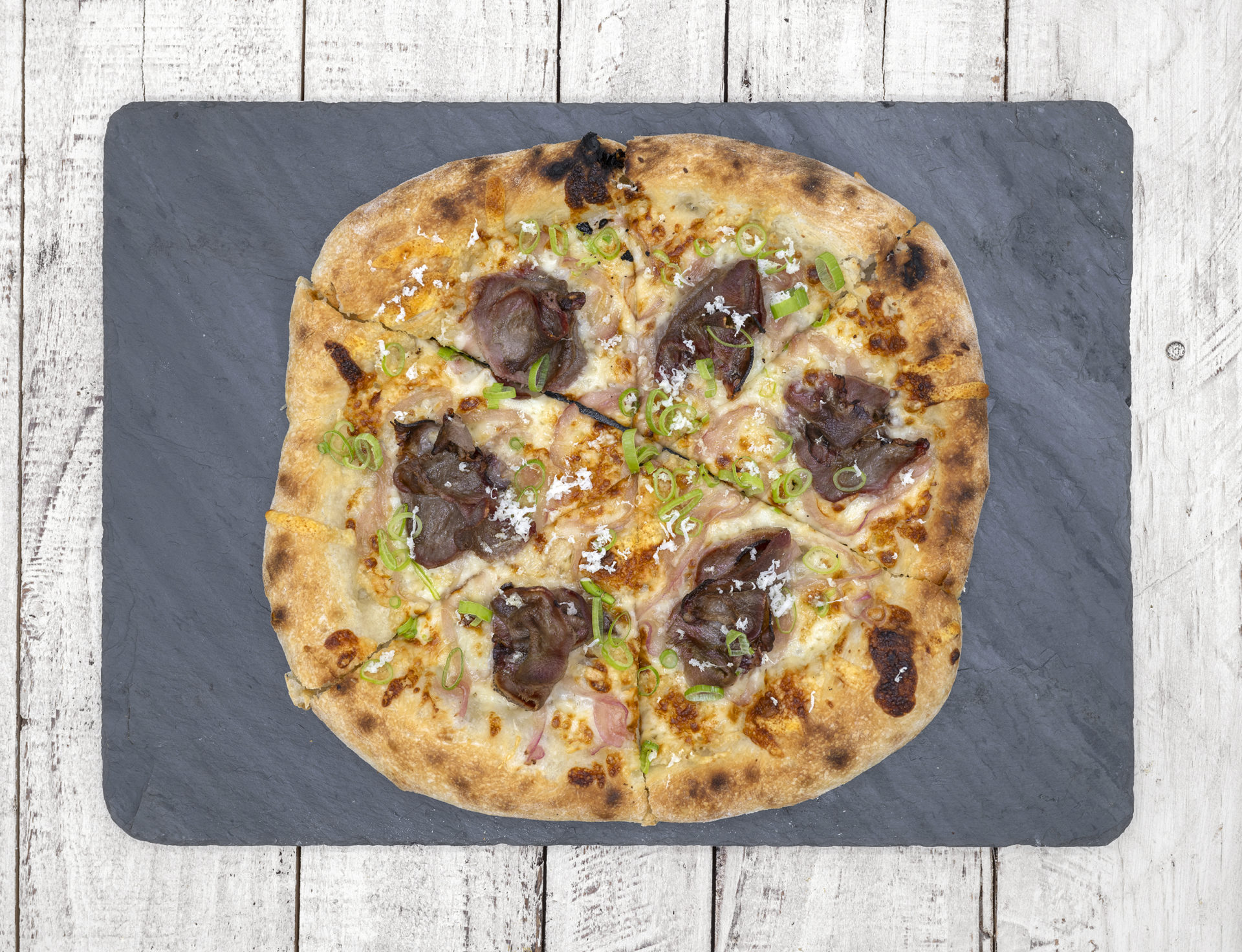
3 comments
Wow, what a delightful twist on pizza! I can’t wait to try this Slovenian creation – it’s like a culinary adventure in every bite. Thanks for sharing this one-of-a-kind recipe!
Enjoy a delicious pizza at unbeatable prices with our Pizza Deals in Brampton. Our famous pizzeria offers a variety of toppings, from traditional pepperoni to exotic veggie blends, catering to every taste. Take advantage of our budget-friendly offers for a solo treat or family gatherings. Indulge in mouthwatering pizza in Brampton without sacrificing flavor or quality, only at Popular Pizza.
Do you make a Slovenian pizza too?